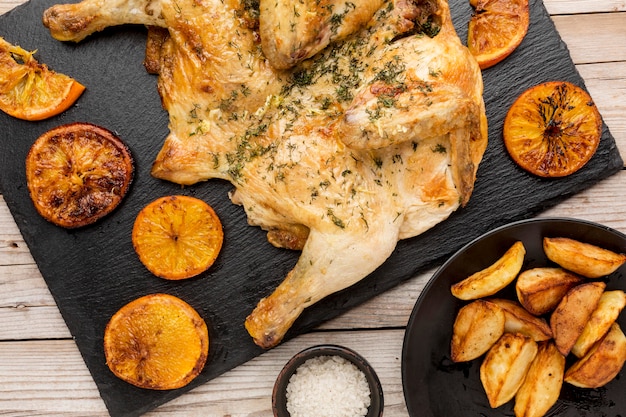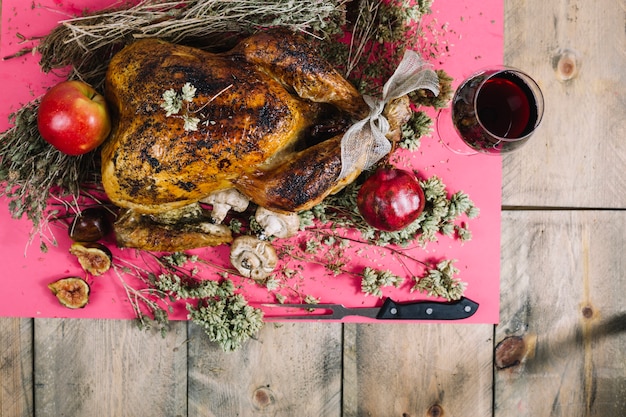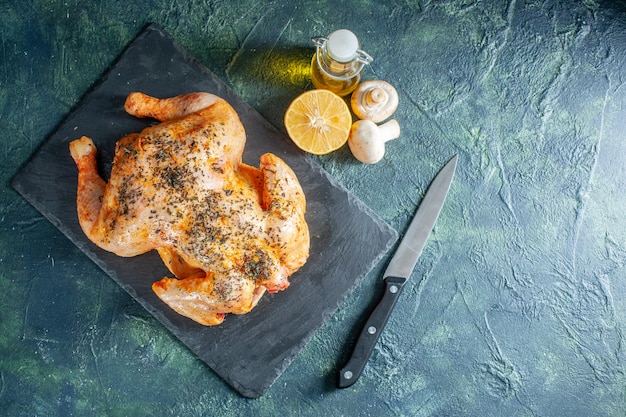Let's be honest, cooking a chicken in the oven can feel a bit like a culinary tightrope walk. You've got all these variables to consider: oven temperature, chicken size, and even the specific recipe you're following. But trust me, I've been there, and I'm here to share what I've learned after years of roasting chickens.
This guide is your ultimate resource for all things oven chicken temperature. We'll be diving into the basics of oven temperature, exploring the importance of chicken weight, and even getting into some handy tips for achieving that perfect, juicy, and crispy roast. So grab your favourite beverage, settle in, and let's get cooking!
(Part 1) Oven Temperature Basics

We'll start with the foundation: the standard oven temperature for roasting a chicken is 180°C (350°F). Now, you might be thinking, "Why not just use a lower temperature?" Well, the higher temperature offers several advantages:
- Faster Cooking: A higher temperature means a quicker cooking time, which is especially helpful if you're short on time.
- crispy skin: The high heat helps to create that lovely golden-brown, crispy skin that everyone loves.
- Juicy Interior: While you might think that high heat would dry out the chicken, it actually helps to keep the inside juicy and tender.
But, here's the catch: every oven is unique. Some run hotter, some run colder, which is why relying solely on the oven temperature isn't always the best approach. The secret weapon here? A meat thermometer!
(Part 2) Understanding Chicken Weights

The size of your chicken plays a crucial role in determining the cooking time. A small chicken cooks much faster than a large one, and getting the cooking time right is key to avoiding dry or undercooked chicken.
(Part 2.1) How to Find the Weight
First things first, you need to find out the weight of your chicken. This is usually printed on the packaging, but if you're buying a whole chicken from the butcher, it's best to ask them to weigh it for you.
(Part 2.2) Finding the Right Cooking Time
Once you know the weight, you'll want to consult a chart or recipe for the recommended cooking time. These charts often tell you how long to cook per pound, and you simply multiply that by your chicken's weight. For example, if a recipe suggests 20 minutes per pound, and your chicken weighs 1.5 pounds, you'd cook it for 30 minutes.
However, these times are just guidelines. Every chicken is slightly different, and you should always check the internal temperature with a meat thermometer to ensure it's fully cooked.
(Part 2.3) The Importance of Resting
After cooking, allowing your chicken to rest for at least 10 minutes before carving is essential. This resting period allows the juices to redistribute, resulting in a more succulent, flavorful bird.
(Part 3) Why Resting is a Game-Changer

Think of it like this: you've just pulled your beautiful roasted chicken out of the oven, and it's radiating warmth and delicious aromas. But you're so eager to dig in that you carve it immediately. What happens? You end up with dry, disappointing chicken.
The reason? The juices are still circulating throughout the meat. Resting gives those juices time to settle back into the chicken, resulting in a much more moist and flavorful experience. Resting also helps the meat retain its moisture, so it's a simple step that makes a huge difference in the end.
(Part 4) Stuffing: To Stuff or Not to Stuff?
Now, let's talk about stuffing. It's a classic pairing with roast chicken, but it also presents a potential food safety concern. When you stuff a chicken, the stuffing cooks at a lower temperature than the chicken itself, making it more susceptible to bacterial growth.
(Part 4.1) The Safer Approach: Stuffing on the Side
To avoid the risk of foodborne illness, it's generally recommended to cook your stuffing separately. You can use a casserole dish or even bake it in a small loaf pan. This ensures it's cooked thoroughly and safe to eat.
(Part 4.2) Stuffed Chicken: Taking Precautions
If you're determined to stuff your chicken, you need to be extra vigilant:
- Pre-Cook the Stuffing: Make sure your stuffing is cooked thoroughly before filling the chicken cavity.
- Higher Cooking Temperature: Cook the chicken to a higher temperature than usual, ensuring the stuffing reaches a safe internal temperature of 165°F (74°C).
- Use a Thermometer: Check the stuffing's internal temperature with a meat thermometer to confirm it's reached the safe level.
(Part 5) The Meat Thermometer: Your Culinary Ally
Now, let's talk about the tool that will become your best friend in the kitchen – the meat thermometer. It's a small investment that can save you from countless overcooked or undercooked chicken disasters.
(Part 5.1) Why a Thermometer is Essential
You can't rely on just visual cues to tell if your chicken is cooked through. The only way to be sure is to use a meat thermometer. It's inexpensive, easy to use, and it takes all the guesswork out of cooking chicken.
(Part 5.2) Proper Thermometer Placement
Insert the thermometer into the thickest part of the thigh, ensuring it doesn't touch any bones. Your chicken is fully cooked when the internal temperature reaches 165°F (74°C).
(Part 6) chicken cooking times: A General Guide
Here's a general guide to cooking times for various chicken weights. Remember, these are just guidelines, and you should always check the internal temperature with a meat thermometer to ensure your chicken is cooked through.
| Weight (lbs) | Cooking Time |
|---|---|
| 2-3 lbs | 60-75 minutes |
| 3-4 lbs | 75-90 minutes |
| 4-5 lbs | 90-105 minutes |
| 5-6 lbs | 105-120 minutes |
Keep in mind that these are estimated cooking times, and factors like oven variations and the type of chicken can affect the actual time needed. Always check the internal temperature to ensure doneness.
(Part 7) Signs of a Perfectly Cooked Chicken
You're ready to pull that chicken out of the oven, but how do you know it's truly done? Here's what to look for:
- Golden Brown and Crispy Skin: The skin should have a beautiful golden brown colour and be crispy to the touch.
- Clear Juices: When you pierce the thickest part of the thigh with a fork, the juices should run clear. If they're pink or red, the chicken needs more time in the oven.
- Firm to the Touch: The chicken should feel firm when you press it, not jiggly or loose.
- Internal Temperature of 165°F (74°C): This is the most reliable indicator of doneness. Use a meat thermometer to ensure the internal temperature has reached this level.
If you see any signs of pinkness in the meat, it's not cooked through and needs to return to the oven. Don't take any chances with undercooked chicken!
(Part 8) Saving an Overcooked Chicken
We've all been there. You're focused on ensuring the chicken is cooked through, and you end up overdoing it. You've got a dry, rubbery bird, and it's just not what you envisioned. But don't despair! There are ways to salvage an overcooked chicken:
- Add Some Moisture: Basting the chicken with a little bit of broth or juice can help to soften it up and reintroduce some moisture.
- Shred It for Other Dishes: Overcooked chicken is perfect for making chicken salad, tacos, or soup. Use it in recipes where it won't be the star attraction.
- Get Creative: Embrace the opportunity to get creative with your overcooked chicken. Try incorporating it into a stir-fry, pasta dish, or another recipe that calls for cooked chicken.
FAQs
Here are some frequently asked questions about oven chicken temperature:
1. Can I Cook Chicken in a slow cooker?
Absolutely! slow cooking is an excellent method for cooking chicken, especially if you're looking for a tender and flavorful result. Cook on low for at least 6 hours or on high for at least 3 hours, and remember to use a meat thermometer to ensure it's cooked through.
2. How Do I Prevent Chicken from Drying Out?
Here are a few tips to keep your chicken moist:
- Baste with Butter or Broth: Regularly basting the chicken with melted butter or broth helps to lock in moisture and prevent drying.
- Use a Roasting Rack: A roasting rack elevates the chicken, allowing air to circulate around it for more even cooking and less steaming.
- Don't Overcook: Check the internal temperature regularly to ensure the chicken is cooked through but not overcooked.
3. What if My Chicken is Still Pink in the Middle?
If your chicken is still pink in the middle, it's not cooked through and needs to be cooked for a longer period. It's crucial to cook chicken to an internal temperature of 165°F (74°C) to eliminate harmful bacteria.
4. Can I Cook Chicken in a Skillet?
Yes, you can cook chicken in a skillet on the stovetop. Use a heavy-bottomed skillet and cook over medium heat. Cook for at least 5 minutes per side, or until it's no longer pink in the middle.
5. Can I Freeze Cooked Chicken?
Yes, you can freeze cooked chicken. Let it cool completely, then store it in an airtight container or freezer bag for up to 3 months.
Now you're equipped with the knowledge and tips to confidently cook delicious, perfectly roasted chicken every time. Happy cooking!
Everyone is watching

How to Cook Frozen Lobster Tails Perfectly: A Step-by-Step Guide
RecipesLobster. Just the word conjures up images of lavish meals, special occasions, and a taste of luxury. But let's...

Pork Fillet Cooking Time: How Long to Cook It Perfectly
RecipesPork fillet, or tenderloin as it's sometimes called, is a real favourite in our house. It's so versatile, and...

Pigs in a Blanket Cooking Time: How Long to Bake for Perfect Results
RecipesAh, pigs in a blanket. Just the name conjures up images of those delightful little parcels of crispy pastry en...

The Ultimate Guide to Cooking Delicious Frankfurters
RecipesLet's face it, we all love a good frankfurter. It's a classic, simple, and always satisfying. But let's be rea...

Wolf Meat Recipes: A Guide to Cooking Wild Game
RecipesLet's be honest, you don't see wolf meat at your local butcher shop every day. It's a bit of a wild card, but ...
